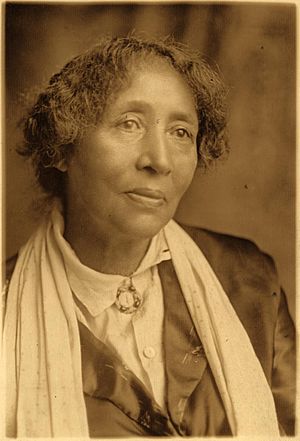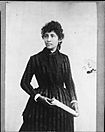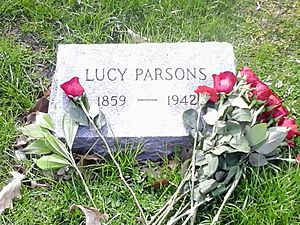Lucy Parsons facts for kids
Quick facts for kids
Lucy Parsons
|
|
|---|---|

Parsons in 1920
|
|
| Born |
Lucia Carter
1851 Virginia, US
|
| Died | March 7, 1942 (aged c. 91) |
| Occupation | Labor organizer |
| Spouse(s) | Albert Parsons |
Lucy Eldine Gonzalez Parsons (born Lucia Carter; 1851 – March 7, 1942) was an American labor organizer and anarchist. This means she believed in a society where people could organize themselves without a strong government controlling everything. She was known for being a powerful speaker. Lucy became involved in social movements after she married newspaper editor Albert Parsons. They moved from Texas to Chicago, where she helped with his newspaper, The Alarm.
After her husband was executed in 1887 because of the Haymarket affair, Lucy Parsons continued to be a very important activist in America. She helped start the Industrial Workers of the World and was part of other groups working for change.
Contents
Biography
Early life
Lucy Parsons was born Lucia Carter in Virginia in 1851. Her mother, Charlotte, was an African-American woman who was enslaved. In 1863, during the Civil War, Lucy's owner moved to Waco, Texas with his enslaved people. He did this to avoid the Emancipation Proclamation, which said that all enslaved people would be free starting January 1, 1863.
We don't know much about Lucy's life after she moved to Texas. She worked as a seamstress (someone who sews clothes) and a cook for white families. In 1871, she married Albert Parsons, who had been a soldier. They had to leave Texas in 1873 because people didn't like their marriage since they were from different racial backgrounds. On their journey, she changed her first name to Lucy. The couple settled in Chicago, Illinois.
Becoming an Organizer
The Chicago Police Department once called Lucy Parsons "more dangerous than a thousand rioters." She and her husband became very effective anarchist organizers in the late 1800s. They were mainly involved in the labor movement, which worked for better conditions for workers. They also helped political prisoners, people of color, the homeless, and women. Lucy started writing for The Socialist and The Alarm. The Alarm was a newspaper for the International Working People's Association (IWPA), which she and Albert helped start in 1883.
Lucy worked closely with her friend Lizzie Holmes in the early 1880s. Together, they led marches of working seamstresses in Chicago. In 1886, her husband, Albert, was arrested. He had been working hard to get an eight-hour day for workers. He was accused of being involved in the Haymarket affair and was executed on November 11, 1887. Many people believed he was wrongly accused. This event led to the start of May Day labor rallies, which are protests for workers' rights.
Lucy Parsons was asked to write for a French anarchist newspaper called Les Temps Nouveaux. She also spoke alongside famous people like William Morris and Peter Kropotkin when she visited Great Britain in 1888.
In 1892, she briefly published her own newspaper, Freedom: A Revolutionary Anarchist-Communist Monthly. She was often arrested for giving speeches in public or sharing anarchist writings. While she continued to support the anarchist cause, she sometimes disagreed with other activists, including Emma Goldman.
In 1905, Lucy helped create the Industrial Workers of the World (IWW). This was a big union for workers. She also started editing Liberator, an anarchist newspaper that supported the IWW in Chicago. Lucy began to focus more on problems like poverty and unemployment. In January 1915, she organized the Chicago Hunger Demonstrations. These protests encouraged other groups, like the American Federation of Labor and Jane Addams' Hull House, to join a large demonstration on February 12. Lucy Parsons famously said: "My idea of the strike of the future is not to strike and go out and starve, but to strike and remain in, and take possession of the necessary property of production." She was talking about "sit-down strikes," where workers stay in their workplaces to protest.
In 1925, she started working with the National Committee of the International Labor Defense. This was a group led by people who believed in communism. They helped defend labor activists and African Americans who were wrongly accused, like the Scottsboro Nine. Most people believe Lucy Parsons joined the Communist Party in 1939.
Disagreements with Emma Goldman
Emma Goldman and Lucy Parsons were both important anarchists, but they came from different generations and had different ideas. This sometimes led to disagreements between them.
Lucy Parsons believed that problems faced by women were linked to how capitalism worked. Emma Goldman, however, focused more on the idea of freedom for women in general, no matter the time or place. Goldman's ideas were more common in the anarchist movement of the 1890s.
In 1908, a police captain stopped one of Emma Goldman's talks in Chicago. Newspapers reported that almost all famous anarchists were there, except for Lucy Parsons. This showed that Lucy and Emma were not close friends. Emma Goldman later supported a book about the Haymarket Affair that was mostly fiction. Lucy Parsons, however, had published a book with the real speeches of the Haymarket martyrs.
Lucy Parsons was very focused on helping working-class people. She criticized Goldman for speaking to mostly middle-class audiences. Goldman, in turn, accused Parsons of only being famous because of her husband. It seems there was some competition between the two women.
Death
Lucy Parsons continued to give powerful speeches in Chicago's Bughouse Square even when she was in her 80s. She inspired many people, including writer Studs Terkel. One of her last big speeches was to striking workers at International Harvester in February 1941. This company was related to the McCormick Harvesting Machine Company, which was involved in the Haymarket affair.
Lucy Parsons died on March 7, 1942, in a house fire in Chicago. She was about 91 years old. Her partner, George Markstall, died the next day from injuries he got trying to save her. After her death, the police took her large library of over 1,500 books. She is buried near her husband at Waldheim Cemetery (now Forest Home Cemetery), close to the Haymarket Martyrs' Monument in Forest Park, Illinois.
Origins and Ethnicity
Lucy Parsons did not like to talk about her personal life or where she came from. When people asked her for details, she would say, "I am not a candidate for office, and the public have no right to my past. I amount to nothing to the world and people care nothing of me. I am battling for a principle." This made it hard for historians to learn about her background.
Parsons specifically said she was not the child of an enslaved African person. She claimed she was born in Texas and that her parents were Mexican and Native American. She called herself a "Spanish-Indian maiden" to explain her darker skin. These stories about her background continued even after her death. On her death certificate, her parents' names were listed as Pedro Díaz and Marites González, both born in Mexico.
Legacy and Tributes
The Lucy Parsons Center was started in 1970 in Boston, Massachusetts. It is still a bookstore run by a group of people who share radical ideas.
In the 1990s, an artist in Chicago created a memorial for Parsons in Wicker Park. In 2004, the city of Chicago named a park after Lucy Parsons.
On July 16, 2007, a book that supposedly belonged to Lucy Parsons was shown on the PBS television show, History Detectives. The show found that the book, which was about Albert Parsons' co-defendant August Spies, was probably sold by Lucy Parsons herself. She likely sold it to raise money to try and save her husband from execution. The show also shared information about Lucy Parsons' life and the Haymarket Affair.
In 2016, The Nation magazine released a short animated film about Lucy Parsons called "More Dangerous Than a Thousand Rioters: The Revolutionary Life of Lucy Parsons."
Lucy Parsons Labs is a group in Chicago that works on digital rights and activism. In 2016, they released documents showing how the Chicago Police Department used devices that connect to people's cellphones to collect data.
In 2022, a new housing complex with affordable apartments was named after Lucy Gonzalez Parsons. These apartments are located near where she spent her final years in Chicago. They provide affordable homes in an area where rents are quickly going up.
See also
 In Spanish: Lucy Parsons para niños
In Spanish: Lucy Parsons para niños






